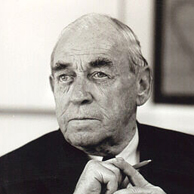
Argomenti affini:
Alvar Aalto
architect - designer (1898-1976)
Alvar Aalto was born in Kuortane in Finland and studied architecture at the Helsinki Polytechnic from 1916 to 1921. He is a great architect and designer of furniture, glass objects, and lighting.
He moved to Jyväskylä where he opened his architectural office in 1923. The following year (1924) marries Aino Marsio.
They spend their honeymoon in Italy, this journey has a profound influence and the Mediterranean culture becomes an important example for the rest of his life.
Alvar Aalto began his career working as an exhibition designer and devoting himself to furniture design in 1925.
He realizes laminated wood furniture, through the folding and gluing of plywood, a technique he uses for the realization of many items, including those of the famous Paimio series.
In 1927 he won the competition for the construction of the South-West Finnish Cooperative Farm, and he moved to the Finnish city of Turku. In 1928 he became a member of the Congrès Internationaux d'Architecture Moderne.
In 1929 he took care of the exhibition project of the Seventh Anniversary of Turku, and opened an experimental laboratory for the processing of plywood with the designer Otto Korhonen, technical director of a furniture factory in the area.
In 1933 Alvar Aalto realizes the construction of the tuberculosis sanatorium in the locality of Paimio in a dense forest about twenty-nine kilometers from Turku. In addition to the design of the building deals with the design of the whole, furnished with a collection of furniture specially designed for the purpose, called Paimio as the locality of the sanatorium.
The work of Alvar Aalto is a great success in the United Kingdom where he is shown in the Exhibition of Finnish Design held in London in 1933, and in France where he performed in Paris in 1937.
In 1935 together with Harry Gullichsen (economist), Maire Gullichsen (professor of visual arts, architecture and design) and Aino Marsio (architect and design), he founded the company Artek where he continues to develop the technique for the production of plywood furniture, which He had already used it before.
In 1936 he built his own house in Helsinki's Munkkiniemi, starting from the principle whereby the starting point in determining the style of a building should be the natural aspect of the landscape that will host it. He later used this theory successfully in the design of many other buildings. The Sunila Community Industry Building is an excellent example.
In 1939 he designed one of the buildings of the New York World's Fair. After World War II he designed the dormitory for students of MIT (Massachusetts Institute of Technology).
In 1957 Alvar Aalto received the gold medal from the Royal Institute of British Architects (RIBA), and in 1958, when he renounced the role of director of the Finnish Association of Architects, won numerous competitions.
In 1960 he built the central buildings of Seinäjoki and Rovaniemi, and in 1963 he became president of the Academy of Finland.
The latest project carried out by Alvar Aalto is that for the university area of Reykjavik, in Iceland (1975-1976).
He died in Helsinki on 11 May 1976, with a life full of projects, achievements and honors behind him.
Alvar Aalto is certainly one of the most important modern architects, starting from architectural rationalism, overcoming the formal schematism, both with the ingenious use of natural materials, and with the research of an architectural space made of wavy lines and surfaces, of open plants and a close relationship between the building and the environment.
Video:
The Aalto House & Studio Aalto: Building Houses that Become Ruins
​Alvar Aalto at Vitra Design Museum / Introduction














